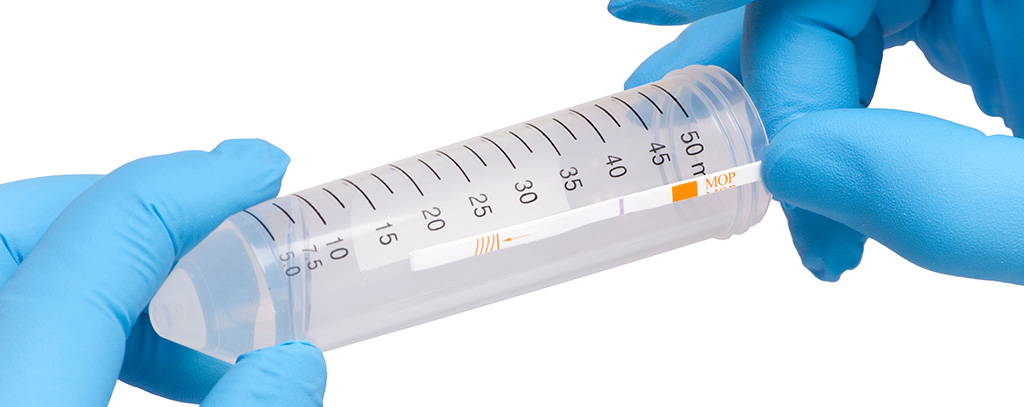


ETG Urine Alcohol Tests: 20 Things to Know
April 28, 2023


Understanding Express Employment Drug Test Procedures
May 1, 2023Understanding how to read a 6 panel drug test is crucial for companies that want to maintain a safe and productive work environment. This type of drug testing is commonly used in the workplace due to its accuracy, cost efficiency, and convenience. In this blog post, we'll provide an extensive overview of the 6 panel drug test - from what it tests for and its advantages to sample collection and results interpretation.
We will begin by explaining what a 6 panel drug test is, including the types of drugs it tests for and its benefits. Next, we'll delve into the testing process itself - from sample collection and preparation to analysis and results interpretation. Furthermore, we'll highlight the advantages of using this specific type of test compared to other methods available.
In addition, we'll outline the necessary supplies needed for conducting these tests accurately and efficiently. Finally, our discussion will conclude with guidance on where you can purchase quality 6 panel drug testing supplies both online or at local pharmacies.
Table of contents
- Importance of Drug Testing in the Workplace
- Different Methods of Drug Testing
- Utilizing Onsite Urinalysis Test Cups
- Reading a 6-panel Drug Test Cup Correctly
- Positive Drug Test Results and Further Investigation
- Maintaining Fairness and Accuracy in Workplace Drug Testing
- Frequently Asked Questions How to Read a 6 Panel Drug Test
- Conclusion
Importance of Drug Testing in the Workplace
Regular drug testing is essential for maintaining a safe workplace environment. Employers can use 6-panel drug tests to detect the presence of various substances, such as marijuana, cocaine, amphetamines, opiates, PCP and benzodiazepines in order to protect employees' safety and productivity. Understanding how to read these tests accurately helps ensure fair treatment of employees who may have legitimate reasons for testing positive due to prescribed medication usage.
Ensuring Employee Safety and Productivity
Drug testing strategies in the workplace are implemented to safeguard personnel and maintain efficiency. By identifying potential substance abuse issues among workers early on through random drug testing or pre-employment screening processes, employers can help prevent accidents caused by impaired judgment or slowed reaction times. Moreover, addressing such concerns proactively contributes towards creating a healthier work culture that values responsibility and accountability.
Reducing Potential Legal Liabilities
- Negligent hiring: If an employer hires someone with a history of substance abuse without conducting proper background checks or drug tests and that person causes harm while under the influence at work, the company could be held liable for negligent hiring practices.
- Vicarious liability: Employers may also face legal consequences if their employees cause damage or injury while under the influence during working hours as they are considered responsible for their staff's actions within specific limits set by law (vicarious liability). Conducting regular drug tests helps mitigate this risk by ensuring workers remain sober while on duty.
- Compliance with regulations: Certain industries, such as transportation and healthcare, have specific drug testing requirements mandated by federal or state laws. Failing to comply with these regulations can have serious consequences, including financial penalties and the potential for loss of business licenses.
In addition to the benefits mentioned above, implementing a comprehensive drug testing policy demonstrates an employer's commitment towards maintaining a safe work environment for all employees. This not only helps attract top talent but also fosters trust among existing staff members who appreciate their company's efforts in prioritizing safety and well-being over potential cost savings achieved by cutting corners on employee health matters.
Drug testing in the workplace is a critical element for employers to guarantee security, efficacy and adherence with laws. Different methods of drug testing are available to meet these needs, each with its own advantages and disadvantages.
Different Methods of Drug Testing
Various techniques for drug testing exist, each with its own benefits and drawbacks. Urine tests, commonly employed in the workplace, are preferred due to their non-intrusive nature and convenience of implementation. Other options include blood tests that offer more accurate results but require trained professionals; Breathalyzer tests primarily used for alcohol detection; and saliva tests that provide quick results but may not be as reliable compared to other methods.
Urine Tests
Urine tests are a popular choice for random drug testing because they can detect a wide range of substances within a specific detection window. These tests analyze an individual's urine sample for traces of drugs or their metabolites, which can indicate recent use. Urine test kits like Halux Diagnostic's Onsite Urinalysis Test Cups make it easy to administer these screenings onsite at your company.
Blood Tests
Blood tests offer more accurate results than urine samples since they directly measure the presence of drugs in the bloodstream rather than their metabolites in urine. However, this method requires trained professionals to draw blood samples, making it less convenient and potentially more expensive than other forms of drug testing.
Breathalyzer Tests
Breathalyzer tests, while mainly associated with detecting alcohol consumption levels, can also be utilized in some cases for detecting certain types of drugs such as marijuana or amphetamines. These tests measure the presence of alcohol or other substances in an individual's breath, providing quick results. However, they may not be as effective in detecting a wide range of drugs when compared to urine or blood tests.
Saliva Tests
Saliva tests are another non-invasive option for drug testing that can provide rapid results. They involve collecting a saliva sample from the person being tested and analyzing it for traces of drugs. While this method is convenient and less intrusive than urine or blood tests, its detection window is generally shorter, making it potentially less reliable for identifying recent drug use.
In order to choose the most appropriate drug testing method for your company's needs, consider factors such as cost-effectiveness, ease of administration, accuracy levels and specific substances you wish to detect within your workforce.
The various methods of drug testing discussed above provide companies with the ability to effectively and efficiently detect drug use in their employees. By utilizing onsite urinalysis test cups, businesses can take advantage of a built-in panel design as well as tamper-resistant features for added security.
Utilizing Onsite Urinalysis Test Cups
One popular method utilized by companies involves using drug test cups like Onsite Urinalysis Test Cups designed specifically for easy onsite detection of drugs. These cups come with built-in panels that change color upon contact with specific substances present in the urine sample provided by the individual being tested. The container itself is also designed keeping harsh transport conditions in mind while ensuring immediate detection post-use.
Built-in Panel Design
The 6-panel drug test cup features a design that incorporates multiple testing strips, each targeting a specific type of drug such as marijuana, cocaine, amphetamines, opiates, phencyclidine (PCP), and benzodiazepines. When the urine sample comes into contact with these strips, they react to any presence of these substances and produce visible lines on the panel's surface. This makes it simple for employers to quickly identify if an employee has used any prohibited substances within their system during random drug testing sessions.
Tamper-Resistant Features
- Temperature Strip: To ensure accuracy and prevent tampering or adulteration attempts made on samples e.g., dilution or substitution with synthetic urine products; most urinalysis test cups come equipped with temperature-sensitive strips that display whether collected samples fall within normal human body temperature range (90°F - 100°F).
- Screw-on Lid: Many brands offer screw-on lids which provide secure sealing preventing leaks during transportation back to laboratories for further analysis if required.
- Tamper-Evident Seal: Some models even feature tamper-evident seals that indicate if the container has been opened or tampered with after collection.
By utilizing onsite urinalysis test cups, companies can efficiently conduct drug testing within their workforce without causing undue stress on individuals being tested. This technique ensures the accuracy of results and also safeguards a work atmosphere that is both secure and productive for all involved staff members.
Utilizing Onsite Urinalysis Test Cups is a great way to ensure accurate and reliable results for drug testing. To further guarantee the accuracy of your test, it's important to know how to correctly read a 6-panel Drug Test Cup.
Reading a 6-panel Drug Test Cup Correctly
To ensure accurate results and maintain a safe work environment, it is crucial to know how to read a 6-panel drug test cup correctly. This involves collecting and securing the urine sample, identifying signs of tampering or adulteration, and interpreting the control line (C) and test line (T).
Collecting and Securing Urine Sample
The first step in reading a 6-panel drug test cup is obtaining a fresh urine sample from the person being tested. Follow the instructions provided with your specific testing kit for proper collection methods. It's essential to secure the sample immediately after collection by sealing it with an appropriate lid or cap.
Identifying Signs of Tampering or Adulteration
Prior to analyzing the results, inspect the collected urine sample for any visible signs that may indicate tampering or adulteration attempts. Some common indicators include unusual colors, odors, or particles floating in the liquid. If you suspect that someone has tried to alter their urine sample,, consider administering another random drug testing at later date.
Interpreting Control Line (C) and Test Line (T)
- Negative Test Result: A negative result will display two lines - one on control line(C) region & other on test line(T). This indicates absence of drugs within detection window.
- Inconclusive Result:If no lines appear either on control line(C) or test line(T), the result is inconclusive. This may occur due to insufficient sample volume, improper testing procedure, or defective test kit. In such cases, it's recommended to retest with a new urine sample and drug test cup.
- Positive Test Result:A positive result will display only one line on control region (C). The absence of any visible lines in the test region (T) indicates presence of drugs above detection threshold levels.
It's important to wait for few minutes after collecting samples before reading results from 6-panel drug tests as this allows adequate time for reaction between panels & urine components. Keep in mind that faint lines appearing within designated regions still indicate negative results as long as they are visible under normal lighting conditions.
Reading a 6-panel Drug Test Cup Correctly is an important skill to have in order to ensure accurate results. By properly interpreting the control line (C) and test line (T), one can confidently move on to further investigate positive drug test results.
Positive Drug Test Results and Further Investigation
After receiving a positive drug test result from an employee, it is essential to further investigate before taking any action; this could include conversations about possible prescription medications and/or additional confirmatory tests such as GC-MS. A positive drug test result requires further investigation, such as conducting a confirmatory GC-MS test to analyze chemical compounds in the sample.
Discussing Potential Prescription Medication Usage
Once a drug test returns with an affirmative outcome, the initial step is to converse with them about their existing medication consumption. Some prescribed medications can cause false-positive results on certain panels of the 6-panel drug test. Benzodiazepines, utilized to treat anxiety issues, may be indicated by a positive result on the benzodiazepine component of the 6-panel drug test. It is essential to give employees an opportunity to explain their medical situation and provide documentation if necessary.
- Maintain confidentiality: Ensure that discussions around prescription medication usage remain confidential between you and your employee.
- Evaluate potential impact: Consider whether the specific medication could affect job performance or safety in your workplace environment.
- Fair treatment: Remember that individuals who use prescribed medications under proper guidance should not be penalized for testing positive due to legitimate reasons.
Confirmatory Testing Methods such as GC-MS
For further clarification, employers may choose to use gas chromatography-mass spectrometry (GC-MS) testing as a more precise method of confirming drug test results and identifying any potential substance abuse issues. This advanced technique can provide more definitive results by analyzing the chemical compounds present in the urine sample, helping to rule out false positives and confirm substance abuse issues.
Some key points to consider when opting for GC-MS testing include:
- Cost: Confirmatory tests like GC-MS can be more expensive than initial screening methods. Employers should weigh the costs against potential benefits of obtaining accurate test results.
- Turnaround time: Results from GC-MS testing may take longer to obtain compared to rapid onsite drug tests. It is essential to factor this into your decision-making process and inform employees about any delays in receiving their test results.
- Laboratory selection: Choose a reputable, accredited laboratory with experience conducting GC-MS testing for workplace drug testing purposes. This ensures that you receive reliable, accurate results from your confirmatory tests.
In summary, handling positive drug test results requires careful consideration and further investigation before taking action against an employee. By discussing potential prescription medication usage and considering additional confirmatory tests like GC-MS if necessary, employers can maintain fairness while addressing possible substance abuse concerns within their workforce.
Positive drug test results should always be followed up with further investigation to ensure accuracy and fairness. To maintain these standards, proper interpretation of the test results is essential for balancing safety concerns with employee rights.
Maintaining Fairness and Accuracy in Workplace Drug Testing
By choosing appropriate methods such as urine tests with onsite urinalysis cups and following proper guidelines when interpreting results, companies can efficiently detect potential substance abuse issues within their workforce without causing undue stress on individuals being tested.
Proper Interpretation of Test Results
To ensure accurate interpretation of drug test results, it is crucial that employers follow the manufacturer's instructions closely. In addition, they should be aware of the Substance Abuse and Mental Health Services Administration (SAMHSA) guidelines for workplace drug testing programs. Some key points to consider include:
- A negative test result does not necessarily mean that an individual is completely free from drugs; it only indicates that the concentration levels are below the detection window set by SAMHSA.
- For a more reliable outcome, it is recommended to use GC-MS for confirmation of any positive test results before taking disciplinary action against an employee.
- If there are concerns about tampering or adulteration attempts made on a sample, additional measures such as retesting or alternative testing methods might be necessary.
Balancing Safety Concerns with Employee Rights
In order to strike a balance between maintaining safety standards at work and respecting employee rights, organizations must implement well-defined drug testing policies. These policies should outline the circumstances under which random drug testing may be conducted, as well as any consequences for employees who test positive. Furthermore, it is essential to:
- Provide clear communication about the company's drug testing policy and procedures.
- Offer support and resources for employees struggling with substance abuse issues, such as access to counseling or treatment programs.
- Maintain confidentiality of test results and respect employee privacy throughout the entire process.
Incorporating these best practices into your workplace drug testing program can help ensure that both safety concerns and employee rights are taken into consideration while maintaining a fair and accurate approach towards detecting potential substance abuse issues within your workforce.
Frequently Asked Questions How to Read a 6 Panel Drug Test
What is a typical 6 panel drug test?
A typical 6 panel drug test screens for six commonly abused substances, including amphetamines, benzodiazepines, cocaine metabolites, marijuana (THC), opiates, and phencyclidine (PCP). This type of test is often used in workplace settings to ensure employee safety and productivity.
How do you read a temp strip?
To read a temp strip on a urine sample container or drug testing cup, simply observe the color-coded temperature indicator. The color change corresponds to the temperature range of the collected specimen. A valid sample should fall within human body temperature range (90-100°F / 32-38°C) as this indicates that it was not tampered with or adulterated.
What is Drugs of Abuse panel 6 drug panel?
Drugs of Abuse Panel 6 refers to a specific configuration of drugs tested in a multi-panel screening device like urinalysis cups. It typically includes six common substances: amphetamines, benzodiazepines, cocaine metabolites, marijuana (THC), opiates and phencyclidine (PCP). These panels help employers identify potential substance abuse issues among employees.
What is the interpretation of drug test results?
Interpreting drug test results involves analyzing control lines (C) and test lines (T) visible on each respective substance's designated area after conducting an onsite urinalysis. If both C and T lines are visible, the result is negative. If only C line appears, it's a positive result indicating drug presence. No lines or just T line indicate an invalid test that requires retesting.
Conclusion
Realizing the capacity to recognize six distinctive medications, this kind of testing can furnish precise outcomes in a timely manner. Understanding the testing process, advantages, and necessary supplies is key in ensuring proper administration.
If you're looking for high-quality 6 panel drug testing supplies, consider checking out Project's selection. With reliable products and competitive pricing, they offer everything you need to conduct effective drug tests. Don't wait - visit https://haluxdiagnostic.com/ today!





